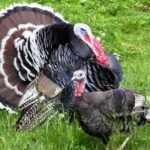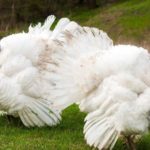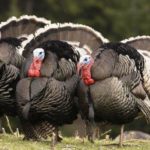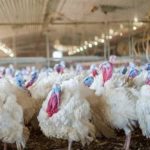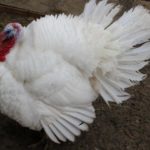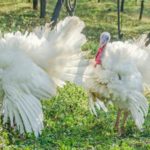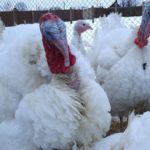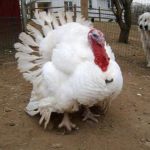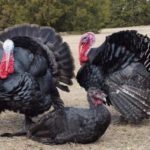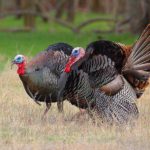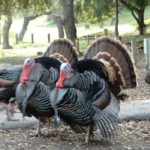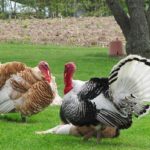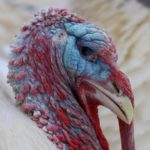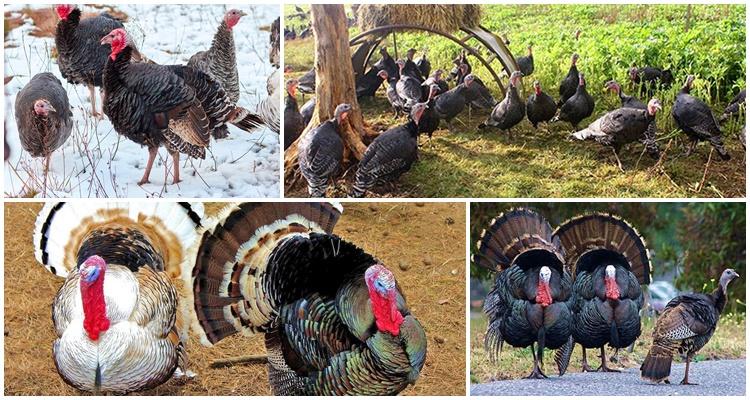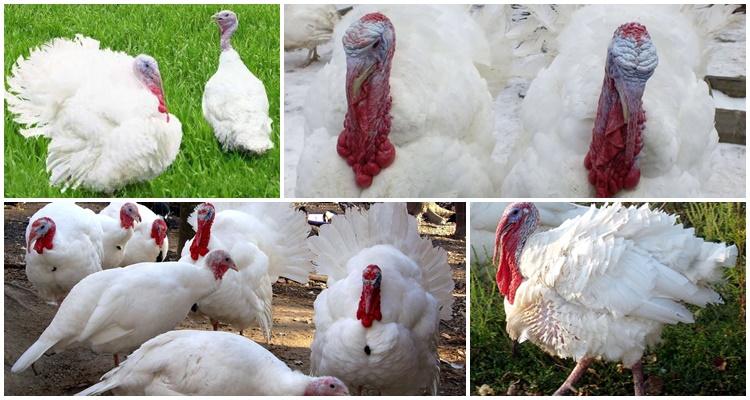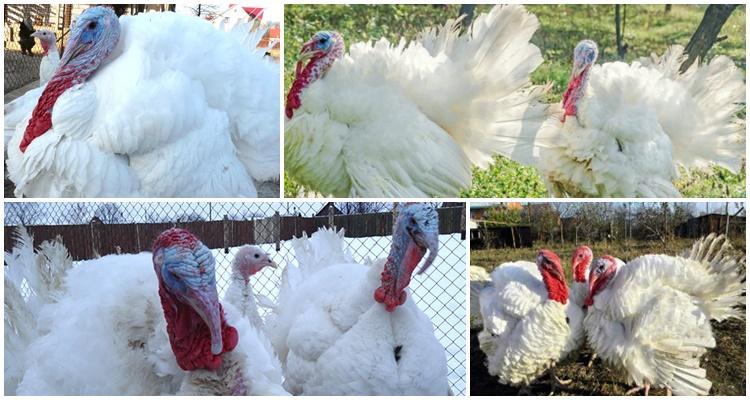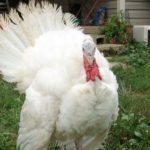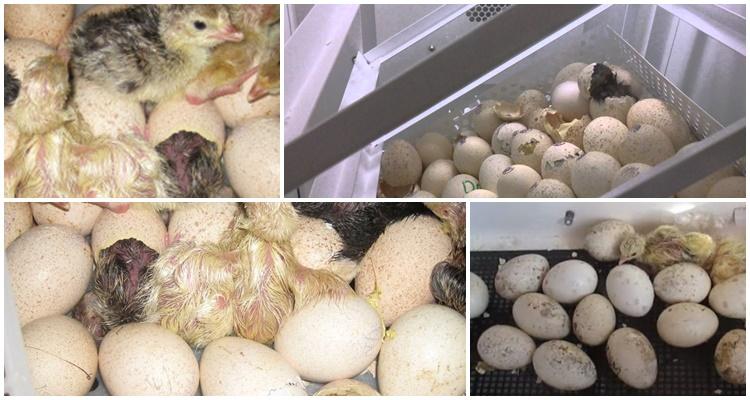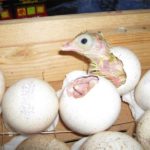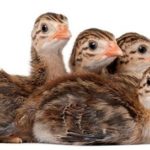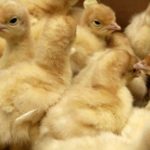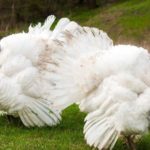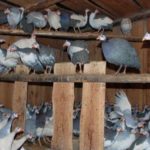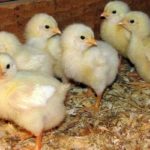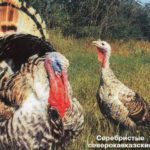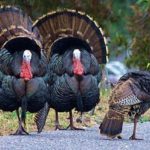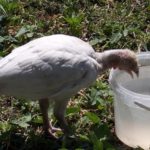One of the objectives of breeding work to develop new breeds of poultry is to improve meat productivity. Along with chickens, broiler breeds of turkeys appeared. Initially heavy birds gain maximum weight in a short period of time. The cost of maintaining broilers pays off faster, so it is profitable to raise them for private farmers and large farms.
- General description and characteristics of broiler turkeys
- Varieties
- Canadian broad chested
- White broad-breasted
- Big 9 and Big 6
- Moscow bronze
- Advantages and disadvantages
- Requirements for maintenance and care
- Walking area
- Cellular content
- Brooder
- Eating at home
- Breeding for Beginners
- Diseases and their treatment
General description and characteristics of broiler turkeys
Broilers are divided into three weight groups: heavy, medium and light. The largest turkeys belong to the heavyweight category and produce up to 30 kilograms of meat per carcass. The maximum weight in the medium and light categories is 18 and 10 kilograms. The peculiarity of highly productive meat breeds of turkeys is that they are ready for slaughter at four to six months. Birds grow over weeks and months. The weight gain of week-old turkey poults is more than one hundred percent of the weight gained within three days after hatching. During the second week, the chicks gain 105 percent of their previous weight.
The rate of weight gain in kilograms is shown by the following weight table by month:
| Age | Turkeys | Turkeys |
| 3 days | 0,055 | 0,056 |
| 7 days | 0,14 | 0,160 |
| 14 days | 0,340 | 0,390 |
| 30 days | 1,1 | 1,4 |
| 2 months | 3,7 | 4,8 |
| 3 months | 7,3 | 9,8 |
| 4 months | 9 | 14,3 |
| 5 months | 11 | 16,9 |
| 6 months | 11,8 | 17,8 |
Longer rearing is not beneficial, as weight gain slows down and the birds begin to get sick. The fragile bones of broilers are not proportional to their mass.
Varieties
Four breeds of broiler turkeys are common on large farms and private farmsteads.
Canadian broad chested
The breed belongs to the medium weight category and is distinguished by its beautiful black and bronze plumage. At 1.5 months, broilers weigh 5 kilograms and are actively gaining weight by three months. Later the gain slows down.
To breed offspring, you need to purchase an incubator and brooder.
White broad-breasted
Turkeys are distinguished by white plumage and gain 11-20 kilograms.
Meat breeds do not have high egg production.But white broad-breasted turkeys are capable of laying up to one hundred eggs a year.
Big 9 and Big 6
Selected breeds of turkeys belong to the heavy group and are crossed with each other.
In private farms, Big broiler turkeys can be raised only seasonally, for meat.
Moscow bronze
The domestic cross turkey weighs 22 kilograms.
The skin of bronze breeds is mottled under dark plumage, while that of snow-white breeds has an attractive, even color.
Advantages and disadvantages
General positive aspects raising broiler turkeys for meat:
- high demand for dietary product;
- additional income from the sale of chicks and eggs;
- short holding period before slaughter;
- rapid weight growth.
Broilers do not need to be kept on complex feed mixtures for a long time. Birds gain weight well on feed.
Problems encountered when breeding turkeys:
- it is necessary to obtain permission from a veterinarian to sell products;
- high mortality of chicks due to errors in housing conditions.
In general, raising broiler breeds is profitable, since the costs of purchasing and maintaining birds will be recouped after the sale of the first batch of meat.
Requirements for maintenance and care
The hatched chicks are kept in a brooder for the first month of life, as they are sensitive to conditions.The survival rate of chicks is 80 percent or higher with proper care. In the second month of life, turkey poults are placed in a poultry house. Cage housing is suitable for broilers. But birds that move freely are less likely to suffer from leg diseases. Basic requirements for conditions in broiler house:
- area - one square meter per mature individual;
- temperature - stable +20 degrees;
- lighting - fluorescent lamps or natural;
- daylight hours - 14 hours;
- litter - peat, sawdust, straw;
- perches - at a height of 70 centimeters from the floor, installed in tiers, at a distance of 45 centimeters from each other;
- feeders - bunker type;
- drinking bowls - nipple, cup.
In the poultry house there are zones: for feeding - in the light part of the room, for resting with perches - in the dark part. There is also a separate walking area.
Walking area
To allow broiler turkeys to stretch their legs, leave free space in the center of the room. Basins with ash, chalk and crushed shells are also placed there. Taking ash baths, birds clean their feathers. Chalk and shells are mineral supplements to food. In the summer, turkeys are released into a fenced pen in the fresh air. The plot is sown with gentian, yarrow, alfalfa and peas, and fenced with a two-meter mesh. In summer, ash, chalk and shells are placed in an open pen.
Cellular content
Individual cages for turkeys installed stepwise in 2-3 rows. Dimensions:
- length - 2 meters;
- width - 1 meter;
- height - 60 centimeters.
The floor of the cages should be solid, plastic or wood. You can put cardboard on the grid bottom. A straw bedding is also placed. The drinking bowl and feeder are installed on the door.
When keeping turkeys in cages, broilers are also allowed to walk around the room with cages or are placed in a pen in the fresh air.
Brooder
Closed cages with microclimate regulation are called brooders. They replace the mother turkey for chicks hatched in an incubator. Broiler poults slowly adapt to their environment. Therefore, in the first two days, the temperature in the brooder is maintained at the same level as in the incubator - 37 degrees. Then, every 3 days, the heating is reduced by 2 degrees. After a month, the chicks will get used to the normal temperature of +21 degrees. In the room with brooders, they also maintain a high temperature - they start at +27 and gradually lower it.
Eating at home
The hatched turkey poults are fed for the first time within 24 hours. Feeding mode:
- 1st week - 9 times a day;
- 2nd week - 6 times a day;
- 3rd and subsequent weeks - 3 times a day.
On the first day, the chicks are given finely chopped boiled eggs. On the second and third days, add cottage cheese. From the fourth day, turkey poults are fed pre-start feed or wet mixtures are prepared using meat, fish broth or yogurt. Gradually add vegetables, grains, meat and bone meal and herbs. They stop producing eggs at one month of age.
The diet of broiler turkeys includes:
- powdered milk;
- corn;
- millet;
- crushed oats, barley;
- soybean meal;
- sunflower cake;
- fish, bone meal;
- chopped boiled potatoes, carrots;
- green onions;
- alfalfa.
To awaken the appetite, turkeys are given spices: pepper, ginger, garlic, anise.
Breeding for Beginners
Broilers are bred using an incubator or by laying eggs in hens. Embryos mature in 28 days.For hens, a nesting area is allocated in the poultry house, in which cardboard boxes are placed with sawdust or straw at the bottom. One hen is allocated an area of 60x60 centimeters. The following eggs are suitable for incubation development:
- with a whole smooth shell;
- correct shape;
- the yolk is located closer to the blunt end;
- The air chamber is clearly visible through the ovoscope.
The incubator is heated to 38 degrees 12 hours before laying the eggs. Humidity is set at 60 percent. The temperature of the eggs when laying should be at room temperature. They are not washed, but wiped with hydrogen peroxide.
The necessary conditions in the incubator throughout the period are shown in the temperature and humidity table:
| Day | Temperature
in degrees Celsius |
Humidity
in percentages |
| 1-3 | 38,3 | 60 |
| 4-14 | 37,6-38 | 40-45 |
| 15-24 | 38-37,5 | 60-65 |
| 25-28 | 37 | 70 |
In order for the eggs to warm up evenly, they need to be turned over: for the first time - 12 hours after being placed in the incubator, the next time - at equal intervals of 3-6 hours. For convenience, the incubators are equipped with an automatic turning system.
From the beginning of the laying, the incubator is opened slightly for 15 minutes for ventilation 2 times a day, and from the 15th day - 3 times.
Diseases and their treatment
Broilers become infected with diseases typical of turkeys:
- enteritis - inflammation of the digestive tract, manifested in the form of diarrhea, treated with antibiotics and probiotics;
- mycoplasmosis is a fungal infection of the respiratory tract that develops in chicks and adult turkeys when fed moldy grain, treated with the antibiotic “Chlortetracycline”;
- histomoniasis is a bacterial infection transmitted from chickens and geese, causing foamy diarrhea and weight loss; Furazolidone is added to the feed of sick birds;
- worm parasites are destroyed with anthelmintic drugs “Piperazine”, “Phenothiazine” and a preventive run is carried out every six months;
- conjunctivitis - watery eyes and swollen eyes are treated with antibacterial drops;
- sinusitis - inflammation of the mucous membranes develops in turkey poults when the room is insufficiently heated; for treatment, a course of antibiotics is prescribed and the temperature in the poultry house is regulated.
To prevent diseases, incubators, brooders and poultry houses are disinfected before introducing new birds. It is also important to monitor the expiration date of food and remove uneaten portions. Broilers should be purchased from reputable farms and the offspring bred independently should be vaccinated.

